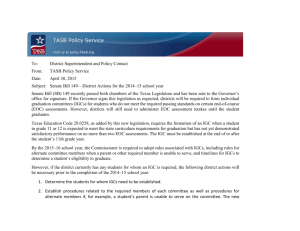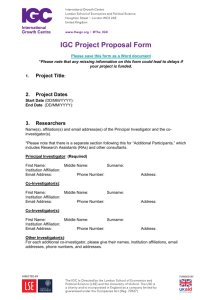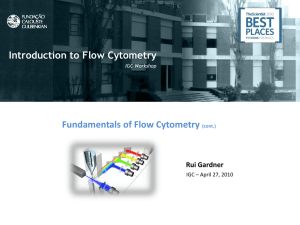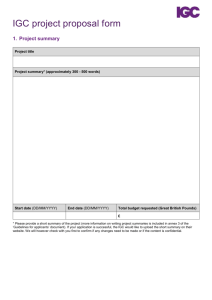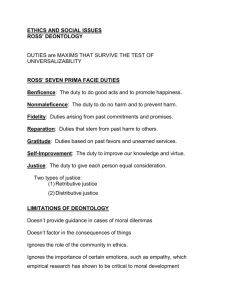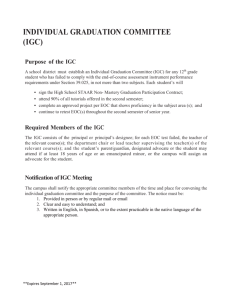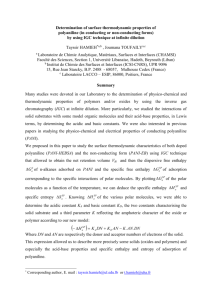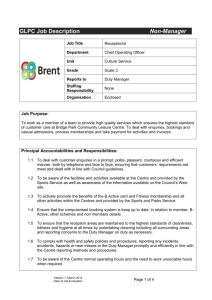Exam Memo - Blenderlaw
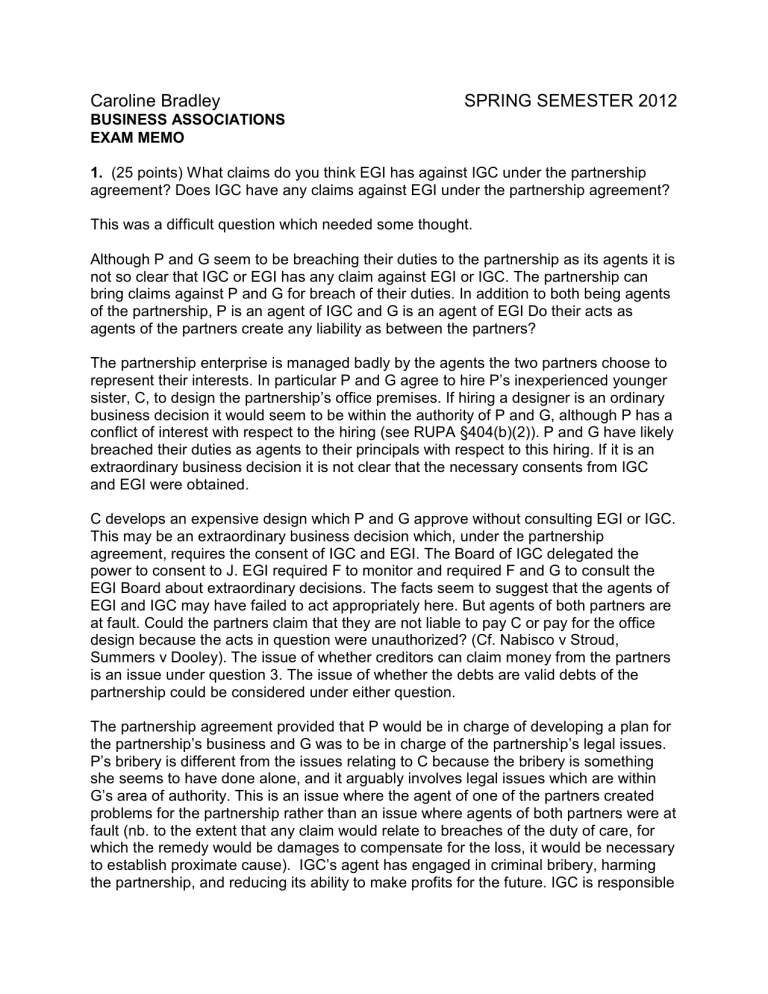
Caroline Bradley
BUSINESS ASSOCIATIONS
EXAM MEMO
SPRING SEMESTER 2012
1.
(25 points) What claims do you think EGI has against IGC under the partnership agreement? Does IGC have any claims against EGI under the partnership agreement?
This was a difficult question which needed some thought.
Although P and G seem to be breaching their duties to the partnership as its agents it is not so clear that IGC or EGI has any claim against EGI or IGC. The partnership can bring claims against P and G for breach of their duties. In addition to both being agents of the partnership, P is an agent of IGC and G is an agent of EGI Do their acts as agents of the partners create any liability as between the partners?
The partnership enterprise is managed badly by the agents the two partners choose to represent their interests. In particular P and G agree to hire P’s inexperienced younger sister, C, to design the partnership’s office premises. If hiring a designer is an ordinary business decision it would seem to be within the authority of P and G, although P has a conflict of interest with respect to the hiring (see RUPA §404(b)(2)). P and G have likely breached their duties as agents to their principals with respect to this hiring. If it is an extraordinary business decision it is not clear that the necessary consents from IGC and EGI were obtained.
C develops an expensive design which P and G approve without consulting EGI or IGC.
This may be an extraordinary business decision which, under the partnership agreement, requires the consent of IGC and EGI. The Board of IGC delegated the power to consent to J. EGI required F to monitor and required F and G to consult the
EGI Board about extraordinary decisions. The facts seem to suggest that the agents of
EGI and IGC may have failed to act appropriately here. But agents of both partners are at fault. Could the partners claim that they are not liable to pay C or pay for the office design because the acts in question were unauthorized? (Cf. Nabisco v Stroud,
Summers v Dooley). The issue of whether creditors can claim money from the partners is an issue under question 3. The issue of whether the debts are valid debts of the partnership could be considered under either question.
The partnership agreement provided that P would be in charge of developing a plan for the partnership’s business and G was to be in charge of the partnership’s legal issues.
P’s bribery is different from the issues relating to C because the bribery is something she seems to have done alone, and it arguably involves legal issues which are within
G’s area of authority. This is an issue where the agent of one of the partners created problems for the partnership rather than an issue where agents of both partners were at fault (nb. to the extent that any claim would relate to breaches of the duty of care, for which the remedy would be damages to compensate for the loss, it would be necessary to establish proximate cause). IGC’s agent has engaged in criminal bribery, harming the partnership, and reducing its ability to make profits for the future. IGC is responsible
Bradley Business Associations Exam Spring 2012 for the acts of its agent (even unauthorized acts can be attributed to the principal). We did not read cases about partners’ duties of care, but RUPA §404(c) states that a
“partner's duty of care to the partnership and the other partners in the conduct and winding up of the partnership business is limited to refraining from engaging in grossly negligent or reckless conduct, intentional misconduct, or a knowing violation of law.”
The corporations cases we read suggest that it is possible to make an argument that breaching the criminal law is a duty of loyalty violation, but partnerships are different from corporations. RUPA § 404 describes the duty of loyalty owed by partners in terms which would seem to exclude this argument.
The partnership agreement limits the fiduciary duties owed by the partners, but RUPA
§ 103 restricts the ability of partners to limit fiduciary duties in a partnership agreement, for example the partnership agreement may not “unreasonably reduce the duty of care”.
Using partnership moneys to pay for the Minister’s stay at the EGI casino involves using funds in which EGI has an interest to pay EGI for the accommodation etc. EGI should be able to claim from IGC with respect to this payment made by IGC’s agent.
The partnership agreement commits the partners to provide expertise to the partnership business. It may be possible to argue that IGC’s choice of P as its agent was a breach of this provision of the partnership agreement.
The partners may wish to dissolve the partnership. The question does not state whether it is a partnership for a term or at will. The partners could agree to dissolve the partnership or either partner could apply for a judicial dissociation.
A number of answers discussed J’s contract to consult with Elbonia in response to question 1 as the taking of a partnership opportunity. This would be relevant if J owed fiduciary duties to the partnership as a partner or as a non-partner agent but J’s role with respect to the partnership business seems to be to consent to extraordinary decisions as an agent of IGC rather than as an agent of the partnership. He owes duties to IGC rather than to the partnership (his position contrasts with P’s - she owes duties to IGC and to the partnership). When he meets the Minister at the EGI casino he does not seem to be at the casino in the context of performing duties to the partnership and the Minister does not sem to be offering him the opportunity because of his relationship with the partnership as far as we can tell. He likely is in breach of his duties to IGC - this point is relevant to question 2. And he seems to be taking the opportunity in his personal capacity rather than as an agent of IGC (which would have raised the issue of whether IGC was competing with the partnership business or taking a partnership opportunity).
2
Bradley Business Associations Exam Spring 2012
2.
(25 points) If minority shareholders in IGC and EGI want to sue directors and officers of those corporations what should they argue? What problems will they face ?
This was a much more obvious question than question 1.
Shareholders of both corporations are concerned that the way in which the corporations have dealt with the partnership business has caused loss to the corporations (the initial decision to enter into the partnership, including the terms of the partnership agreement and the monitoring of the partnership’s operations). Thus there are issues with respect to the directors’ duty of care, including §102(b)(7) issues (the question does not state whether IGC or EGI has such a provision in force, although the relevant statutes are in the form of the Delaware statute so it would be possible). This would include some discussion of the compliance issues with respect to the bribery (e.g. Stone v Ritter).
Discussion of the business judgment rule would be appropriate (making bad decisions does not in itself give rise to any liability).
In addition to the duty of the Boards to monitor there are issues with respect to breaches of duties by officers of the corporations. Section 102(b)(7) does not help people who are officers rather than directors, and this may be an issue for Petra and
George (as officers of IGC and EGI and as persons responsible for managing the partnership business they owe duties to the partnership and to the corporation of which they are officers). J’s contract with Elbonia should be discussed here - is it a corporate opportunity? Also Petra’s informing her husband about the Azeroth Integrity
Commission investigation.
Claims with respect to breaches of directors and officers’ duties are derivative claims, therefore there should be some discussion of whether there is any basis for demand excusal. On the facts as described there does not seem to be much of a basis for claiming demand excusal. The decision to enter into the partnership does seem as though it may have been taken in a way that does not satisfy the business judgment rule (e.g. Smith v Van Gorkom) but if there is a §102(b)(7) provision then the plaintiffs would have to plead a lack of good faith etc. The other issues are (1) acts of individual officers which raise the question of whether the Boards are sufficiently independent to make the decision as to whether litigation is in the corporations’ best interests. We do not have sufficient facts to answer this question, and (2) issues about the Boards’ monitoring of the partnership business. The fact that Board members are defendants in any litigation is not sufficient on its own for demand excusal. We would need more facts.
Shareholders who bought shares after the announcement of the partnership might have claims under §10(b) and Rule 10b-5 if there were materially misleading statements about the venture. A delay in disclosing information about the investigation into bribery could also raise issues under §10(b) and Rule 10b-5 (cf. Basic v Levinson).
3
Bradley Business Associations Exam Spring 2012
3.
(20 points) If the partnership has insufficient assets to satisfy the claims of its creditors can the creditors look to the partners for payment ? Would it make a difference if the partners had decided to establish an LLP or LLC instead (and they had become limited liability partners or member/managers)?
I thought this was a pretty obvious question. Nevertheless, many people seemed to have difficulties with the idea of a corporation as a partner which might be liable for partnership debts. Corporations have assets, which is what matters to creditors, and there is no hint that the corporations are insolvent in the facts of the hypo. However, a number of answers examined the possibility of creditors of the partnerships being able to pierce the corporate veils of IGC and EGI. Veil piercing allows creditors to impose liability on shareholders and not on directors or officers in their capacity as such (here we are told nothing about share ownership of any of the directors and officers in the facts). The cases we read on veil piercing all involved corporations with one or two owners (including a corporate owner). Veil piercing does not happen with respect to publicly traded corporations like the ones described in the question. (Although in a group bankruptcy there may be equitable consolidation, but we did not discuss that and you were not expected to know anything about that doctrine). So, discussion of veil piercing with respect to a general partnership was not, I think, relevant. And discussing veil piercing as a mechanism for imposing liability on directors was wrong.
In a general partnership creditors must first look to the assets of the partnership to satisfy their claims and only after partnership assets have been exhausted may they look to the assets of the partners (RUPA § 306, 307). But they do have unlimited liability for debts of the partnership unless creditors agree to limits on liability. Partners have the apparent authority to bind each other to acts in the ordinary course of the partnership business.
The question then invites a discussion of the limited liability shields for LLPs and LLCs.
Note that the question asks about LLPs and not LPs - many answers treated this as a question about LPs and LLCs. In class we spent more time discussing what limited liability in an LLP meant than we did in the context of the LP.
With respect to the LLP see RUPA § 306(c) : obligations of LLPs are solely obligations of the partnership and a “partner is not liable, directly or indirectly, by way of contribution or otherwise, for such an obligation solely by reason of being or so acting as a partner.” This shield looks to be more reliable than the LLC shield may be because courts have allowed veil piercing with respect to LLCs. In an appropriate case of fraud it might be possible to persuade a court to look through an LLP
The limits on liability are conditional on maintenance of the LLP status, and on publicity.
And if partners have received moneys as their share of profits when there were in fact no profits it may be possible to recover such payments (e.g. Brobeck, Phleger &
Harrison Bankruptcy).
4
Bradley Business Associations Exam Spring 2012
With respect to such issues in LLCs we read Kaycee Land and Livestock v Flahive (on veil piercing) and New Horizons Supply Co-operative v Haack (on dissolution).
4.
(15 points) If a partnership agreement governed by RUPA limits the partners' fiduciary duties "to the maximum extent permitted by law,” how do you think a court should go about defining the maximum extent?
Some people seemed to think that the question was asking how one should interpret a partnership agreement which stated that the fiduciary duties which applied between partners would be the maximum permitted by law. This is not what the facts of the hypo or this question suggest is going on. Instead the question is about the extent to which partners can limit fiduciary duties which would otherwise apply.
This is intended to be a normative question (how should a court go about defining the maximum extent) rather than a question which asks for what the rule is. But it would be appropriate to consider how a court which was to apply RUPA to an agreement with this language could perform its task. The difficulty seems to be that RUPA has particular requirements for contracting around the duty of loyalty that this language does not address. RUPA §103 states that the partnership agreement may not eliminate the duty of loyalty but may “identify specific types or categories of activities that do not violate the duty of loyalty, if not manifestly unreasonable” (this language was provided in the exam). The provision of the partnership agreement cannot be treated as eliminating the duty of loyalty as RUPA does not permit this, but nor does it seem to specify any activities which could be treated as not violating the duty of loyalty. RUPA §103 states that the partnership agreement may not unreasonably reduce the duty of care. Here there is no statutory language to regulate the content of a provision limiting the duty so it may be possible for the court to think about what the limits of contracting out of the duty would be. The duty of care under RUPA § 404 is limited to “refraining from engaging in grossly negligent or reckless conduct, intentional misconduct, or a knowing violation of law.” Might eliminating liability for gross negligence be acceptable under the statute?
As to the normative issue, there’s scope to consider what the function of fiduciary duties is. Are they merely gap fillers (in which case it would be possible for people to contract around them) or do they have regulatory content?
5.
(15 points) Under what circumstances would Petra’s husband, and/or his friend, incur liability based on these facts? Do the facts raise any other legal issues?
This is an O’Hagan question.
P is IGC’s Vice President for Business Development, and an insider with respect to
IGC. She is also an employee (and agent, therefore a fiduciary) of the partnership
5
Bradley Business Associations Exam Spring 2012 between EGI and IGC with access to information about an important component of
EGI’s business. She is not a traditional insider with respect to EGI, but there’s a good argument she should be treated as an insider. If not she is certainly within the scope of the misappropriation doctrine because of her duties to the partnership and IGC.
When the partnership was announced the market for shares in both corporations reacted favourably (“When IGC and EGI announced the establishment of the partnership the shares of both corporations increased significantly in price.”) After the market becomes aware of what has been happening in the partnership the question states that the “market price of shares in IGC and EGI collapses.” The information P has seems to be material and non-public and she is under a duty to the partnership and to IGC not to use it for purposes other than the partnership’s and IGC’s business.
Under §10(b) and Rule 10b-5 she is subject to a duty to disclose or abstain from trading or tipping.
When P gives information to her husband she may be violating her fiduciary duties or not. Under Dirks she would incur tipper liability if she gives the information for personal gain. And if her husband knew about her breach of duty he would also become bound by the obligation not to disclose - tipping the friend would then be in breach of §10(b) and Rule 10b-5, and if the friend’s sale is part of the same picture of benefiting or avoiding a loss through the breach of duty the friend would also be liable.
If P gives the information to her husband as part of their relationship involving the sharing of confidences and an expectation that the husband will maintain the confidentiality of the information ( a fiduciary type relationship under Rule 10b5-2) she may avoid liability. But her husband would be caught by O’Hagan. If he uses the information to trade or passes it on in breach of his duty to P (presumably for personal gain) he would be liable. And if the friend were to be knowingly involved in this breach of duty the friend would also be liable.
The other issues part of this question could be a hook for discussion of other aspects of insider trading or other issues generally raised by the facts of the question.
6

